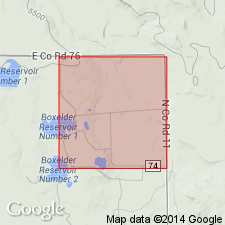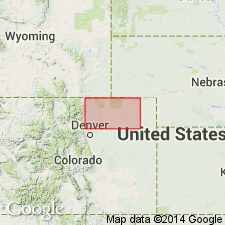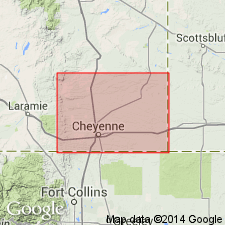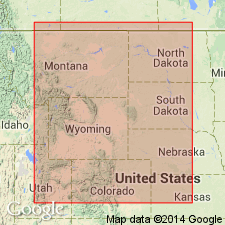
- Usage in publication:
-
- Richard sandstone
- Modifications:
-
- First used
- Dominant lithology:
-
- Sandstone
- AAPG geologic province:
-
- Denver basin
Summary:
First published use for a sandstone exposed along north bank of Richard Lake (source of geographic name) in sec 30, T8N, R68W, Larimer Co, CO in the Denver basin. No type locality designated. Is the top sandstone of five named unranked sandstones in the Mesaverde formation. Overlies an unnamed sandy shale of the Mesaverde. Overlying unit not given. Is 59 ft thick. [No lithologic description given.] Cretaceous age.
Source: GNU records (USGS DDS-6; Denver GNULEX).

- Usage in publication:
-
- Richard sandstone member*
- Modifications:
-
- Overview
- AAPG geologic province:
-
- Denver basin
Summary:
Recognized as one of five sandstones assigned as a member of Pierre shale rather than as an unranked unit of the Mesaverde formation. Separated from the older Larimer sandstone member of Pierre by 115 ft of beds. Lies about 5,198 ft below top of Pierre. Consists of brown-gray to green, limy concretionary thin-bedded sandstone 30 ft thick in a section measured on Fossil Creek south and southeast of Fort Collins. Has large biotite flakes that give the sandstone a speckled appearance. Usually ranges between 25 and 60 ft thick. Geologic map. Not separately mapped from the Pierre. Pierre forms extensive outcrops in Larimer, Morgan, and Washington Cos, CO in the Denver basin. Of Late Cretaceous age.
Source: GNU records (USGS DDS-6; Denver GNULEX).

- Usage in publication:
-
- Richard Sandstone Member*
- Modifications:
-
- Areal extent
- AAPG geologic province:
-
- Denver basin
Summary:
Geographically extended northward into WY along the Laramie Mountains. Replaces use of Parkman Sandstone Member in Denver basin. Recognized at Francis Ranch on the outcrop in Ts14 and 15N, R69W, Laramie Co, WY and in the subsurface in Apache Co., 1 Polo Ranch in sec 14, T14N, R66W, Laramie Co, WY. Is a member of Pierre Shale 10 ft thick that overlies and underlies unnamed shale of the Pierre. Consists of gray to orange, very fine grained, very clayey, slightly calcareous sandstone. Thought to be a shoreface deposit. Forams. Campanian age. Nomenclature chart; measured section.
Source: GNU records (USGS DDS-6; Denver GNULEX).

- Usage in publication:
-
- Richard Sandstone Member*
- Modifications:
-
- Biostratigraphic dating
- AAPG geologic province:
-
- Denver basin
Summary:
Is a member of Pierre Shale in Larimer Co, CO in Denver basin. Collections of the ammonite genus RHAEBOCERAS from several localities indicate an early Maestrichtian (Late Cretaceous) age. General stratigraphic position of RHAEBOCERAS includes the zones of BACULITES REESIDEI Elias and B. JENSENI Cobban.
Source: GNU records (USGS DDS-6; Denver GNULEX).
For more information, please contact Nancy Stamm, Geologic Names Committee Secretary.
Asterisk (*) indicates published by U.S. Geological Survey authors.
"No current usage" (†) implies that a name has been abandoned or has fallen into disuse. Former usage and, if known, replacement name given in parentheses ( ).
Slash (/) indicates name conflicts with nomenclatural guidelines (CSN, 1933; ACSN, 1961, 1970; NACSN, 1983, 2005, 2021). May be explained within brackets ([ ]).

